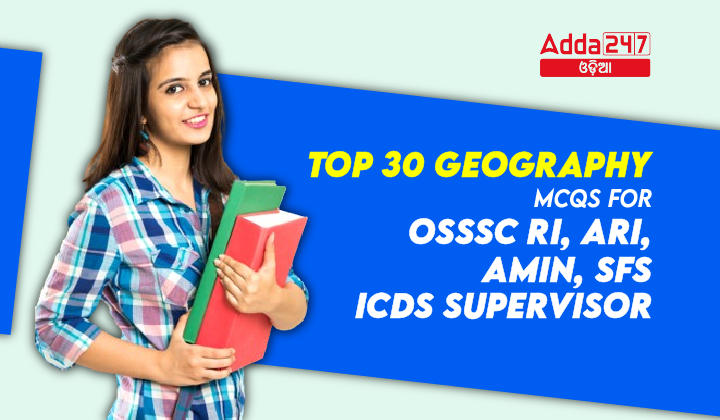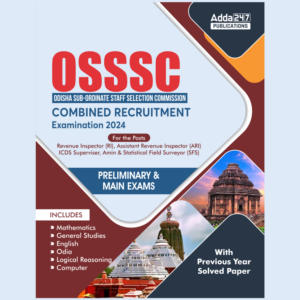Geography plays a crucial role in various competitive exams, including OSSSC RI, ARI, AMIN, SFS, and ICDS Supervisor. To assist candidates in their preparation, we have compiled a set of 30 Multiple Choice Questions (MCQs) at a moderate difficulty level. Each question is accompanied by a correct answer to enhance your geographical knowledge and better prepare you for the upcoming exams.
Top 30 Geography MCQS For OSSSC RI,ARI, Amin, SFS, ICDS Supervisor
These geography MCQs cover a range of topics, providing a comprehensive review for candidates preparing for OSSSC RI, ARI, AMIN, SFS, ICDS Supervisor exams.
- When can Baily’s beads be observed?
a) Occultation of Jupiter
b) Partial solar eclipse
c) Lunar eclipse
d) Total solar eclipse
Answer: d) Total solar eclipse - The weight of an object on the moon is equal to ___ of its weight on the earth.
a) 1/10th
b) 1/6th
c) 1/8th
d) 1/4th
Answer: b) 1/6th - Which of the following statements about Ganymede is NOT correct?
a) It is bigger than Mercury.
b) It is the largest natural satellite in our solar system.
c) It is the only moon known to have its own internally generated magnetic field.
d) It revolves around Saturn.
Answer: d) It revolves around Saturn - Planetary scientists call the thin gaseous envelope around the Moon as the _____?
a) Lunar exosphere
b) Lunar stratosphere
c) Lunar thermosphere
d) Lunar endosphere
Answer: a) Lunar exosphere - Which of the following is the outermost solid part of the Earth?
a) Mantle
b) Crust
c) Core
d) Caldera
Answer: b) Crust - The ____ is responsible for Earth’s magnetic field?
a) Inner core
b) Mantle
c) Outer core
d) Crust
Answer: c) Outer core - The moon is an example of a ______ object?
a) Transparent
b) Translucent
c) Luminous
d) Non-luminous
Answer: d) Non-luminous - The process that moves, elevates, or builds up portions of the earth’s crust is called:
a) Denudation
b) Volcanism
c) Weathering
d) Diastrophism
Answer: d) Diastrophism - When are neap tides produced?
a) When the sun and moon are at right angles to the earth.
b) When the sun partially contracts pull of the earth.
c) When the earth and moon are in a straight line.
d) When the sun lowers the gravitational pull of the moon.
Answer: a) When the sun and moon are at right angles to the earth. - How many natural satellites does the planet Venus have?
a) 1
b) 2
c) 0
d) 3
Answer: c) 0 - What is the approximate period between two consecutive new moons?
a) 15.5 days
b) 28.5 days
c) 29.5 days
d) 15 days
Answer: c) 29.5 days - During the phenomenon of aphelion, the approximate distance between the earth and the sun is?
a) 137 million km
b) 152 million km
c) 147 million km
d) 142 million km
Answer: b) 152 million km - In the sequence of planets in the solar system, which planet comes in between Mars and Saturn?
a) Venus
b) Mercury
c) Uranus
d) Jupiter
Answer: d) Jupiter - Europa is the natural satellite of?
a) Saturn
b) Uranus
c) Jupiter
d) Mars
Answer: c) Jupiter - Which of the following is the outer layer of the Earth that is made of plates which fit together like a jigsaw puzzle?
a) Lithosphere
b) Biosphere
c) Mesosphere
d) Asthenosphere
Answer: a) Lithosphere - When does a solar eclipse occur?
a) an asteroid comes between the sun and the moon
b) the moon moves too far away from the sun
c) the sun comes between the moon and the earth
d) the moon comes between the earth and the sun
Answer: d) the moon comes between the earth and the sun - Which of the following is known as the study of earthquakes?
a) Seismology
b) Lithology
c) Semiology
d) Histology
Answer: a) Seismology - The theory that dinosaurs were driven to extinction by the aftermath of a large asteroid impact on Earth was given by?
a) Wilhelm Rontgen
b) Luis Alvarez
c) Henry Moseley
d) William Crookes
Answer: b) Luis Alvarez - About 70% of the Sun is made up of?
a) Hydrogen
b) Oxygen
c) Carbon
d) Helium
Answer: a) Hydrogen - The term ‘Blood Moon’ is used to refer to?
a) Solar Eclipse
b) Crescent Moon
c) Lunar Eclipse
d) Full Moon
Answer: c) Lunar Eclipse - What is the approximate diameter of the sun compared to the diameter of Earth?
a) 92
b) 109
c) 146
d) 123
Answer: b) 109 - In India, the Ursa Major Constellation is also known as:
a) Devarshi
b) Maharshi
c) Saptarshi
d) Swadeshi
Answer: c) Saptarshi - What is the uppermost layer of the earth’s surface called?
a) Mental
b) Core
c) Magma
d) Crust
Answer: d) Crust - In the life cycle of a star, the stage “nebula” refers to:
a) The stage when the outer layers expand, cool down, and become less bright
b) The last stage of its life
c) A cloud of dust and hydrogen
d) The outer shell of a star
Answer: c) A cloud of dust and hydrogen - “Lucifer” is another name for the planet:
a) Jupiter
b) Mars
c) Venus
d) Saturn
Answer: c) Venus - Which celestial body is no longer considered a planet within Earth’s Solar system?
a) Neptune
b) Pluto
c) Mars
d) Uranus
Answer: b) Pluto - Which planet is made up of thick white and yellowish clouds of sulfuric acid?
a) Mars
b) Uranus
c) Neptune
d) Venus
Answer: d) Venus - Which of the following planets is known as a gas giant?
a) Earth
b) Mercury
c) Venus
d) Jupiter
Answer: d) Jupiter - What are the bodies glowing in the night sky known as?
a) Celestial bodies
b) Asteroids
c) Planetarium
d) Meteorite
Answer: a) Celestial bodies - Which one of the following is the largest recognized constellation?
a) Hydra
b) Dorado
c) Antilla
d) Crux
Answer: a) Hydra
















